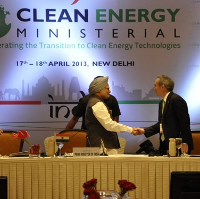14 June 2013
GEA authors join the clean energy dialogue
Participants in the event discussed how GEA findings can help achieve Clean Energy Ministerial (CEM) goals for a transition to a global clean energy economy. The event was chaired by Kirit Parikh, IIASA Council Member and former member of the Indian Planning Commission. For videos and presentations from the event, click here.
Anand Patwardhan, GEA co-chair and professor at the University of Maryland, led off the presentations with an introduction to GEA pathways that achieve the energy goals of access, climate mitigation, and security. Patwardhan said, “The purpose of the GEA is to understand what kind of transformation is needed for a more sustainable future, and what the elements of that transformative change might look like, and how such a transformative change could be accomplished.”
Jyoti Parikh, Executive Director of the Integrated Research and Action for Development (IRADe), then presented findings from a recent report that takes GEA findings to a national level, examining energy development scenarios for India. She said, “The GEA results were at a regional level – but who makes the decisions for South Asia as a region? It’s necessary to check these results at a country level and get concrete feedback. That’s what we did.”
IIASA researcher Shonali Pachauri then presented GEA findings specifically related to energy access, including electricity and clean cooking. She pointed out that in India, two-thirds of people still do not have access to electricity. But historical analysis shows that complete electrification can occur on the order of 2 to 3 decades. Pachauri said, “Combining policies is key to achieving these goals. If we only apply subsidies for modern fuels, we find that we do reduce dependence on solid fuels, but this alone will not get us to where we need to go. If we give microfinance on new stoves, this also achieves partially the goal, but would not achieve the goal of 2030 universal access.”
Getting to policy
Policymakers participating in the event lauded the comprehensive report, and asked for more specific prescriptions on how to use the report in policymaking at the national and local level. In particular, they asked for advice on how to integrate such a comprehensive, systems-level report, in a policymaking community that remains divided.
U.S. Department of Energy Deputy Assistant Secretary Jonathan Pershing said, “The notion that the energy sector can be neatly sliced into an element that’s about energy security, an element about access, an environmental component, and a global climate component, I think is false, and you have nicely addressed this. This integration is a critical component of your conclusion. But at the same time it raises a difficulty for the policy community, which is in fact not as integrated.”
Karsten Sach, of the German Federal Ministry for the Environment pointed out the need to take the global assessment to a local and regional level, where most policymaking happens.
Subho Banerjee, of the Department of Resources, Energy, and Tourism, Australia, said that policymakers recognize the value of a systems approach. But, he said, the next step is to take the complex report and find simple messages that can be used to make policy. He said, “What policymakers are looking for is the simplest set of rules that we could set up to reach these goals.”


